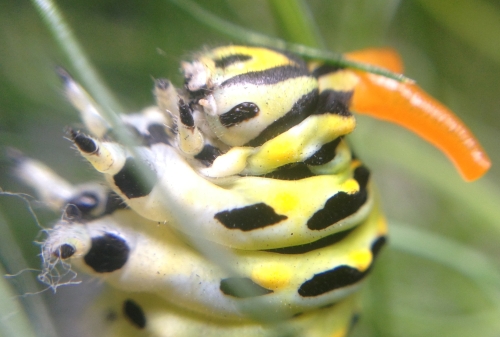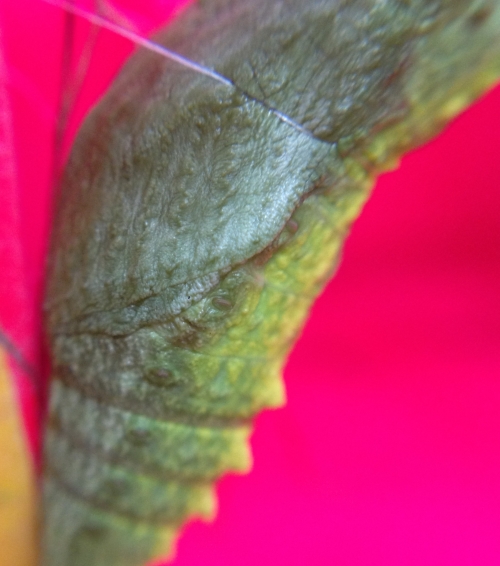I had so much fun raising Monarch butterflies for an outreach event a couple months ago, I decided to repeat the process with another type of butterfly- the Anise Swallowtail (Papilio zelicaon). Since the last of my butterflies emerged today, I thought I’d take another brief break from bees to show some photos I took while raising my butterflies.

Four Anise Swallowtail caterpillars at different stages of development. Believe it or not, these are all the same species!
Like the Monarch butterfly, Anise Swallowtail caterpillars specialize on a particular group of plants in the carrot family (Apiaceae). The adult butterfly is the only life stage that can fly and move quickly. Adult females lay eggs on the appropriate host plant, in this case, fennel or parsley, because the young caterpillars won’t be able to leave and search for new plants on their own.
I found a couple of young caterpillars on a wild fennel plant growing in my neighborhood, and another two eggs that happened to be laid on my parsley plant:
Young eggs are small and yellow, and turn brownish as they mature.
After a few days, the eggshells turned clear and the caterpillars were about to hatch. The photo doesn’t do it justice, but the eggs were a very pretty opalescent color, like tiny black pearls:
The tiny newly-emerged caterpillars ate the eggshells as their first meal then began to munch on the parsley. The hole to the right of the caterpillar is where the egg used to be.
Because the caterpillars are not necessarily as toxic as the Monarch caterpillars, they have other defenses. The younger stages (instars) disguise themselves by looking a little like bird droppings.
As the caterpillars get older, they start to develop a different coloration pattern (caterpillars grow by shedding their skin, so they are able to change how they look when they molt).
The older caterpillars look almost nothing like the younger ones, but they still have a special defense from predators. When disturbed, they rear their heads and exude yellow horn-like protrusions called “osmeteria:”
This is called a “startle defense.” It “frightens” potential predators into looking for another meal.
At this stage, the caterpillars are absolutely voracious. I had to get new fennel almost every day.
After a couple of weeks, the caterpillars search for a place to pupate. When they find a place, they attach themselves by a silk strand and prepare to pupate.

They can travel some distance to find an appropriate spot- I even found one in my bag across the room!

Fresh pupae can still startle predators by jerking around in their pupal case if disturbed:
The chrysalises can be a variety of colors from green to brown. I don’t know what causes the different colors, but I imagine that they are these colors in order to blend in with their surroundings so as not to be visible to predators.
The chrysalises were not at all smooth and jewel-like as the Monarch chrysalises were. Instead they had some very interesting textural patterns on the surface:
After a couple of weeks, the adult butterflies emerged from the chrysalises. I wasn’t lucky enough to catch the eclosion process, but here are some photos I took of the brand new butterflies:






















You ARE having fun! Beautiful pictures!
Thank you!
WOW! Those are amazingly descriptive and gorgeous.
Thanks! It really was a lot of fun to do.
So gorgeous! Yes indeed the eggs look like pearls – they reminded me of the pearls found in the Philippine seas. Beautiful chronology of the beautiful life.
Gorgeous!
Amazing pictures! Thank you very much
I had noticed a beautiful black butterfly hanging around my herb garden. After a couple of weeks I discovered a caterpillar on my dillweed devouring it voraciously. I thought it was a monarch but looking at this website realized it was an anise swallowtail. I was amazed to find another just like it and 5 tiny ones on the same plant. I’m going out to buy more dill plants to keep them happy. Just amazing! Thanks for your info here.
Gorgeous photos! I have 4 anise swallowtail caterpillars at the moment and one chrysalis!
What type of lens are you using to take these photos?
Thank you!
I’m glad you enjoyed the photos! I am by no means a professional photographer; for taking insect photos I typically use a smartphone with a clip on macro lens. You can find decent ones for under $10 online, if you are interested in taking photos to document the progress of your caterpillars.
Awesome! We discovered about 40 of these bigger ones on my now mostly consumed dill plant this week. A few on my parsley, including some smaller ones that look like bird poop. Lol. I moved the parsley over so they can transfer from one plant to the next. I have about 14 in a butterfly habitat eating fresh dill from the grocery. I’ll grab them some parsley tomorrow and carrot tops as well, dill is not cheap! Lol. My 5 year old is so excited to see them as they grow. Hoping all ours make it to butterflies.
You forgot to mention, as with all swallowtails…when they are getting ready to pupate, they purge just prior to going on their walkabout, that’s how you know they are ready. Looks like very loose frass (poop) 🙂
We are graced with black swallowtails! They also devour rue. I have a big bushy rue plant from which I take large cuttings for after they are larger and not as attached to their “birth plant” which has been fennel or dill. I found 7 eggs on a fennel plant today (with my 4 yo grandson) and six last saturday. Those are popping out today. We’ve released 5 so far. I got to watch the female lay the six last week! We are in SE Michigan. I’ve only seen a few Monarchs this year.